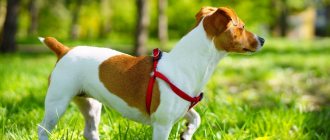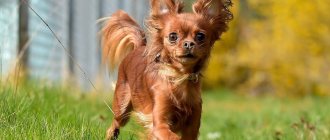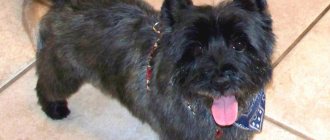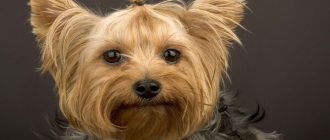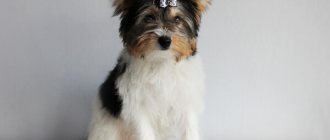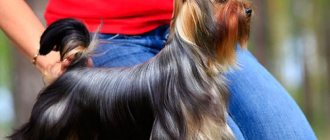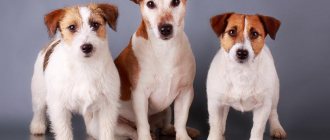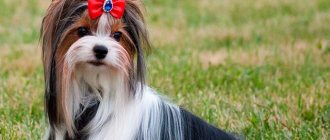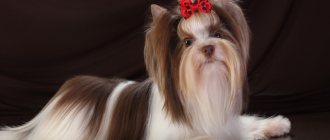| Type |
|
| Size | small (up to 10kg) |
| Main features |
|
| Included in |
|
| Frequent illnesses |
|
| Intelligence | 40% |
Video Yorkshire Terrier | All about the breed
Pointed ears, beady eyes under unruly bangs, a cheerful tail - such a funny Yorkshire Terrier dog. These handsome guys will charm anyone. Many lovers of small dogs dream of owning a Yorkie, although keeping them is associated with quite serious expenses. After all, clothes for a tiny pet are not a luxury at all, and a personal hairdresser is a vital necessity. It will also take a lot of time to care for it.
However, not everyone is susceptible to York addiction. Fans of large breeds of dogs believe that cute babies have a complex and even quarrelsome character. They are stupid, poorly trained, too intrusive and bark for no reason. And in general, this is not a dog, but a small thing, and an unpleasant one at that.
Let's tell you without bias about the Yorkshire Terrier dog, find out what a Yorkie needs for a happy life and what kind of owner will like it.
Owner reviews
Yorkshire terriers firmly hold the palm in popularity among lovers of decorative pet dogs. The high popularity is not associated with the working characteristics of the breed, but with its moral and mental indicators, which allow the animal to find friends, both among people and among other pets. One of the very important advantages of the breed is the fact that the dogs do not shed, and they also do not emit the characteristic dog smell. These animals can be recommended for keeping both elderly, lonely people and families with children. The only problem is the difficulty in predicting the future color of adult animals, since it is necessary to raise the animal from the age of one month. The white spot in the chest area completely disappears only after 6 months of life, which must be taken into account when choosing a puppy.
YORKSHIRE TERRIER - 10 INTERESTING FACTS ABOUT YORKIES | DOG BREEDS with Ellie Dee | Elli Di – Dogs
History of the Yorkshire Terrier breed
The homeland of the Yorkshire Terrier is Great Britain; the breed appeared at the end of the 18th century. She has worker-peasant origin. Among the ancestors of the Yorkie are the Waterside Terriers. These small dogs with blue-gray fur were bred by peasants. The law did not allow them to keep large animals.
According to some reports, a new breed of weavers was developed. They crossed terriers from different regions of England to create a small, fearless dog for exterminating rats in factories. Other sources say that brave Yorkies went underground with miners, again to hunt rodents.
However, it is not known exactly when the workers’ favorite was washed from coal dust, combed and began to be fed with delicacies. There is speculation that professional breeders bred Old English Terriers with the exquisite Maltese. It was from them that Yorkies inherited long and soft fur, like silk. Learn more about a similarly long-haired breed, the Australian Silky Terrier, or Silky.
The first Yorkshire terriers were more elongated and about twice as heavy as modern ones. They weighed an average of 6 kilograms. And the dogs of this breed were called Scotch terriers, that is, Scottish.
The current name of the breed was adopted in 1870. And the ancestor of modern Yorkshire terriers is a dog named Ben of Huddersfield, who was born in 1865. He lived only 6 years, and died under the wheels of a horse-drawn carriage. However, during his short career, Ben managed to win 74 prizes. And most importantly, he became the father of a huge offspring.
At the end of the 19th century, the Yorkshire Terrier was officially recognized by English dog lovers. They organized the first national breed club. Over the next hundred years, breeders worked to reduce the size of the dog. The beginning of the 20th century was not marked by important events in the history of the breed. They forgot about miniature Yorkies for some time; service and large dogs became the peak of popularity.
It was only after the end of World War II that Yorkshire Terriers began to slowly become a fashionable breed. In 1947, 953 puppies were registered with the British club, in 1949 there were over a thousand of them. In 1960, the new generation of English-bred Yorkies numbered 4 thousand puppies.
In the United States, the history of the breed was much the same. Small terriers were brought to the New World back in 1872, and four years later a club for Yorkie lovers was opened. Then they were forgotten for almost half a century. And interest was revived in the late 40s of the 20th century.
In the USA, Yorkshire terriers have become incredibly popular thanks to the dog Smokey. An American soldier found her in 1944 in the forests of New Guinea. This Yorkie is considered the first "therapy dog". She served at the hospital and lifted the spirits of the patients. In addition, Smokey became a television star, she took part in 42 shows. The dog also performed complex tricks. For example, I walked on a tightrope blindfolded. In the United States, a monument was erected to the legendary York.
The Yorkie was brought to Russia only in the early 70s of the last century. The dog was given to ballerina Olga Lepeshinskaya abroad. In the early 90s, the first single-breed nursery was opened in the Moscow region. Now there are more than 75 of them.
In recent years, the popularity of the breed has been steadily growing. In 1998, Yorkshire Terriers were ranked ninth in the American Kennel Club's rankings, and since 2006 they have risen to second place.
Types of animals
The division of Yorkshire terriers into varieties is arbitrary and is not provided for in the official breed standard.
Based on weight, Yorkies are divided into:
- standard – 2-3.1 kg;
- mini – 1.4-2 kg;
- super-mini or micro – no more than 1.5 kg.
You can also distinguish baby-face Yorkies, which have a shorter muzzle, the length of which is equal to a third of the length of the skull.
As a rule, dogs that are too low weight have many health problems and a short life expectancy..
Yorkie appearance
The Yorkshire Terrier is a small but very proud dog. This is noticeable in her appearance. She has a harmonious figure, straight and important posture, and long, beautifully flowing fur. This is what the breed standard says. A Yorkie should weigh no more than three kilograms and two hundred grams; there are no height requirements.
On the small head there are erect ears with a sharp tip. The latest breed standard does not recognize the semi-drop type of ears. The dog's dark eyes look at the world carefully. The expression of the muzzle is extremely intelligent. The small nose is black, as is the lining on the eyelids. The bite is exclusively scissor bite.
Yorkie named Big Boss was included in the Guinness Book of Records as the smallest dog. His height is only 12 centimeters and his weight is 480 grams.
The Yorkie's neck is set beautifully on its graceful body. The straight line of the back continues with a strong lower back. The ribs are slightly rounded. The tail can be docked or full length. It is straight, decorated with long hair of a darker color than on the body, and raised slightly higher than the back. The limbs stand straight, the fur on them is thick, light golden in color. Round feet with black claws. The dog moves easily and freely.
These baby terriers have a long, perfectly straight, soft and shiny coat that falls down the sides of the body and adorns the head and muzzle. The standard color is steel bluish, with a bright golden color on the head, limbs and chest. The tan should be a clean, rich tone, without dark hairs. The color is deeper at the roots and lighter at the ends. You can appreciate all the beauty of Yorkies only at exhibitions. In ordinary life, they are cut short to reduce the hassle of caring for them.
In the distant past
Despite the fact that there is practically no documentation or precise evidence telling about the origin of Yorkshire Terrier dogs, scientists believe that ancient terrier-like rat catchers can be considered their ancestors. To confirm this version, they cite the works of the writer Apir, who lived in the second century BC, in which he mentions a miniature terrier named Agass.
The manuscripts of the Roman naturalist Pliny the Elder, who lived in the first century AD, also describe miniature dogs discovered by the Romans in the British Isles. Many archaeologists, based on these records, believe that the history of Yorkshire Terrier dogs begins precisely with the British Isles, from where sailors took them to different countries.
In the seventh century AD, the Frankish king Dagobert I passed a law prohibiting the killing of a hunting dog similar in description to the modern Yorkie.
Dr. J. Caius, personal doctor of Elizabeth I Tudor, Queen of England, published a book in 1570 in which he mentions miniature dogs - owners of a silky and shiny coat that falls down the sides of the body to the ground. He associates their origin with local small terriers, which were kept by small game hunters.
In Scotland, King James VI of Scotland (aka James I of England), who reigned in 1605, describes in his works Scottish burrow dogs, which were similar in appearance to the Yorkie of our day.
Long-haired terriers with silky hair are also mentioned in their records:
- Dr. Johnson in 1773;
- Thomas Bell in 1837.
Personality of the Yorkshire Terrier
This dog has a toy appearance, but the temperament is like that of a full-fledged terrier. Yorkies are brave, agile and quite independent. They carefully observe everything around them, but do not interfere without reason. They have a balanced but cheerful disposition. Yorkies can become hysterical if they were raised incorrectly or if they have an unstable psyche from birth.
These handsome guys are excellent manipulators. If they need something, they tenderly look into a person’s eyes, lick his hands, wag their tail - and very often get everything they wanted.
Yorkshire Terriers are sociable and friendly, they really like to be the center of attention, show off and communicate. Therefore, it will not be difficult for the owner to place a pet for one of his relatives or friends while he is away. In addition, the dog will not suffer too much due to separation, like Hachiko. He will quickly find new friends and interesting entertainment.
Yorkshire Terriers are renowned for being empaths. They are sensitive to a person’s mood and respond well to intonation and gestures. These dogs are true companions, they are sad and happy with their owner.
Yorkies are friendly towards children and don't mind playing with them. But little dogs are quite gentle and impatient people. If they were hurt, for example, if they stepped on a paw, they may bite the offender. Not out of malice, but simply reflexively. Therefore, a Yorkshire Terrier dog is not suitable for the role of a nanny for a baby and will not be a living toy. You can get a dog for a school-age child who knows how to handle animals carefully.
Yorkies usually get along well with other pets. They are friendly with cats, but may not like rats or other rodents. Perhaps this hostility is an inheritance inherited from mousetrap ancestors. A terrier that is easy-going at home can become aggressive on the street towards strangers. This behavior is especially typical for young male dogs. When they see a stranger, they rush to attack, but they don’t care what size the enemy is. Therefore, the owner needs to be on alert in order to intervene in an unequal fight in time. By the way, castration partly solves the problem of cockiness.
Like all terriers, Yorkies love to run, jump and misbehave. They can bark with pleasure. But this will not be a problem if the dog splashes out energy and plays pranks during a walk. Therefore, you will have to find time to walk your pet and play outdoor games.
A big mistake is to have a pet as a decoration for your home or as a fashion toy. This is a full-fledged member of the family who needs to be raised and trained. Otherwise, the baby will begin to show the worst qualities of character. He will become overly cowardly or, conversely, aggressive, will bark incessantly, constantly demand attention to his person and spoil things.
Possible Causes of Trembling
Many small breed dogs sometimes shake. You should not immediately rush to the veterinarian; this condition can be caused by many factors. During the winter, the Yorkshire Terrier trembles quite often, since the dog is highly susceptible to the effects of low air temperatures due to its size. With such actions, the animal accelerates blood circulation in order to warm up.
Sometimes a pet shakes due to a feeling of fear or in stressful situations. Such a reaction causes intense excitement, pleasure or a feeling of happiness. For example, after a long separation at home you will meet a pet trembling with joy.
But the cause of trembling can be the following diseases: allergies, poisoning or hypoglycemia. The allergic reaction easily goes away after the irritant is eliminated. In addition to trembling, poisoning is accompanied by vomiting and diarrhea. The hallmarks of hypoglycemia (low blood sugar) are constant trembling, weakness and lethargy. If you recognize the cause in time and seek the help of a veterinarian, your pet’s health is not in danger.
Pros and cons of the breed
Yorkshire Terriers have a whole range of wonderful qualities. Thanks to them they have become so popular. However, dogs of this breed have their disadvantages. Basically, they appear if the puppy was raised incorrectly or did not undergo socialization in time. But there are also difficulties that do not depend on the owner.
The advantages of Yorkies include the following qualities:
- very compact size, the dog can easily live even in a small apartment;
- attractive appearance;
- practically does not shed;
- can go to the toilet like a cat, in a tray or on a diaper;
- treat others kindly;
- quite smart, well trained;
- can make friends with other pets;
- you can take him on a trip, they will even allow you to take your Yorkie on board the plane;
- Feeding expenses are very small.
Now let's talk about the few disadvantages of this dog breed:
- grooming is troublesome and expensive;
- needs special hygiene;
- cocky character towards other people's dogs;
- wardrobe expenses will be required;
- high cost of Yorkie puppies.
Breed traits
Breed traits (on a 5-point scale)
| Yorkshire Terrier | |||
| Activity | in the house | 3.8 | |
| on the street | 3.7 | ||
| Obedience | training | 2.9 | |
| strangers | 2.7 | ||
| Domination | in family | 2.1 | |
| over dogs | 2.8 | ||
| Defending your territory | from people | 2.7 | |
| from dogs | 3 | ||
| Sociability | in family | 4.8 | |
| with strangers | 3.7 | ||
| with dogs | 3.1 | ||
| Concentration | in family | 1.2 | |
| in front of strangers | 2.2 | ||
| with dogs | 2.1 | ||
| Aggressiveness | in family | 1.3 | |
| to strangers | 2 | ||
| to the dogs | 2.6 | ||
| to cats | 2 | ||
| Family behavior | calmness | 3.3 | |
| demand for affection | 4.2 | ||
| excitability | 3.8 | ||
| playfulness | 4.1 | ||
| excessive barking | 2.9 | ||
| behavioral breakdowns | 2.2 | ||
| Tolerance for children | up to 4 years | 3 | |
| over 4 years old | 3.7 | ||
| Institutional use | watchman | 3.6 | |
| bodyguard | 1.6 | ||
This breed is often compared to the following dog breeds: Jack Russell Terrier, Shih Tzu, Pug, Chihuahua, Miniature Poodle (Miniature Poodle).
Interesting photos of Yorkshire terriers:
Yorkshire Terrier
Yorkshire Terrier
Raising and training the Yorkshire Terrier
Some people think that a cute toy dog doesn't need to be raised. This is a fatal mistake. Without proper upbringing, a Yorkie will grow up spoiled and even harmful.
From the very first days, the puppy must be accustomed to the place, shown him what not to do. Then accustom him to the nickname, and then teach him basic commands: “come to me,” “sit,” “lie down.” Further, as you wish. You can come up with your own commands and tricks following the example of circus jumps and somersaults. Or you can limit yourself to basic skills. The main thing is that you and your Yorkie feel comfortable living under the same roof, so that the pet and you understand each other. It is also important to adhere to the same rules. All family members must act in concert. Then the dog will quickly figure out and remember what they want from it.
Yorkshire Terriers mature faster than large breed puppies. At about 6 months they already look like adult dogs, and reach their maximum size on average at 8 months.
Many Yorkie owners try to teach their pets to go to the toilet in a diaper or in a litter box in the apartment. This must be done consistently and patiently. We must remember that puppies relieve themselves immediately after sleep and some time after eating. Therefore, after waking up and 10-15 minutes after eating, take the baby to a diaper or in a tray and hold him there until he is done. If he did what was required, praise him and give him a treat. And you will have to do this every time until the kitten gets used to it. You cannot punish for puddles and piles in the wrong places, especially if this did not happen right now. You can scold the puppy a little if you catch him at the “crime scene” and immediately take him to the toilet.
Yorkies at a young age are especially restless and active; they still cannot concentrate for long periods of time. Therefore, the “teacher” must show patience and understanding. Puppy lessons should be short, best done before meals or towards the end of a walk. For success, you need to sincerely praise your pet and give something tasty. You cannot be punished for refusing to carry out a command. Perhaps the puppy is tired. Then you need to switch his attention to the game, and then return to learning again.
Many Yorkshire Terriers successfully master general training or obedience courses. They are trained in agility no worse than large dogs. It is only necessary that the obstacle course be adapted to the small size of the Yorkie.
When the puppy gets comfortable at home and has received all his vaccinations, it is time to get acquainted with the outside world. Nowadays this is commonly called socialization. This is a very important process, especially for small breeds. These dogs become hysterical and aggressive because they are afraid of everything and everyone. Therefore, a young Yorkshire terrier needs to be taken out into society more often, and allowed to communicate with strangers, dogs and other animals. The puppy must get used to street noise and behave calmly in transport. If something causes anxiety in a pet, the owner should reassure and reassure him.
Special mention should be made about walks. Yorkies are very active and curious. They feel bad without fresh air and new experiences. But on the street it is better not to let them off the leash near highways, as well as in unfamiliar and crowded places. These dogs often die under the wheels of cars, and they can also be harmed by larger dogs. In addition, they can run to the side and lose sight of the owner.
A well-trained and socialized Yorkshire Terrier will become a balanced, friendly and confident dog. He will not give you any trouble in any situation.
Description
Yorkshire Terriers are one of the tiniest of the terrier family. Their height at the withers ranges from 21 to 23 cm, weight - from two to three kilograms. They live 12-15 years and are suitable for living in small apartments: they take up little space and shedding is minimal. Suitable for people who have no experience in keeping and raising dogs. Gets along well with children, is distinguished by observation and watchdog qualities. They are very capable of training, but excessive activity and willfulness can interfere with this process. But this is an excellent companion who will share with you all the most active games: the Yorkshire Terrier, whose breed characteristics include agility and courage, can become an excellent partner for restless children and very active adults.
Yorkies are quite easy to care for. So, it is quite possible to train him to use the cat litter: he can easily relieve himself even on newspapers. However, do not deprive him of the pleasure of running and just walking down the street.
The only problem is that these babies do not tolerate the cold very well, so you definitely need to wear one in winter and autumn. In addition, they are quite fragile in build, so it is important to ensure that the baby does not inadvertently get injured.
In addition, it is better to minimize your Yorkie's contact with rabbits, guinea pigs and hamsters.
The main advantage of Yorkies is that these babies hardly shed, and they do not provoke allergies. However, caring for their fur can be a bit of a hassle.
Despite the lack of shedding, your Yorkie's coat needs to be brushed constantly. It is also beneficial to oil his coat regularly. It is better to bathe your baby once every couple of weeks, and to wash the fur you need to use a moisturizing shampoo and conditioner. You can also choose a comfortable haircut.
In addition, you need to provide the baby with toys. Communication with you is more important to him, but loneliness is easier to bear while playing.
Care and maintenance of Yorkie
The Yorkshire Terrier is ideal for keeping in a city apartment. He doesn't need a lot of space, and he can go to the toilet on a diaper or in a litter box, like a cat. But in order for the dog to feel comfortable, the owner will have to buy a lot of things. Yorkies love to sleep in warm houses or on soft beds. The puppy will also need bowls for food and water, a leash, a collar (or a harness, it’s more convenient), and a variety of toys. The more entertainment your baby has, the fewer things he will ruin.
You can't do without clothes for walking. A jumpsuit or jacket for a dog of this breed is not pampering, but a real and urgent necessity. Yorkies do not have an undercoat, so they get cold quickly. It would be nice to add boots to a warm wardrobe. The reagents that are sprinkled on roads in winter cause irritation of the skin on the paws. If the terrier is not cut short, you will need bows and elastic bands to keep the hair in ponytails.
Hygiene and care procedures
Yorkies' fur is very similar to human hair; these dogs practically do not shed. You don't need to comb them out, but you will have to bathe them with a special shampoo and conditioner about once every 10 days. Otherwise, the fur coat will look untidy. Long hair becomes matted and tangles can form.
If a dog takes part in exhibitions, its coat must be cared for in a special way. The owner will need a whole set of special tools. The hair is grown, washed, oiled, curled into curlers, and combed.
Regular pets are usually groomed once every 2-3 months. A short-haired Yorkshire Terrier is much easier to care for. However, visits to a dog groomer cost a lot, so it makes sense to master grooming yourself. You will still have to wash the dog, but less often, 1-2 times a month is enough.
If your Yorkie is never trimmed, his coat will be approximately twice as long as his height.
It is very important to accustom your pet to mandatory grooming procedures from an early age. Reward him for good behavior with something tasty. Then he will calmly, and perhaps even with pleasure, endure all the manipulations.
Yorkies require careful eye care. First of all, you need to make sure that the hairs do not irritate the cornea. To do this, they are cut in a timely manner or put into a ponytail. And the eyes themselves are wiped daily with a napkin moistened with a special lotion, infusion of tea, chamomile, or simply boiled water.
You should brush your teeth at least once every two days. To do this, you can use a special brush or a regular gauze pad coated with veterinary toothpaste.
Nail trimming is another important procedure. Toy dogs that don't run much on the pavement have their claws grow quickly, especially in the front. If you notice that your Yorkie is moving noisily, tapping his claws, or seems awkward in any way, check to see if it's time for a pedicure. To do this, purchase a nail clipper and a nail file. It is better if the veterinarian or groomer shortens the claws for the first time, and you watch how to do it.
Nutrition
Yorkshire Terriers are quite picky eaters. In addition, they often suffer from indigestion and allergies. Choosing a natural diet on your own is a difficult task. Half of the menu should consist of protein products: lean meat (beef, turkey, chicken) and sea fish fillet. These products are lightly boiled. Some owners prefer to give them raw, after scalding them. The second half is cereals (rice and buckwheat), fermented milk products and vegetables. You can add fruit to your diet. You cannot mix different proteins at one meal.
A serving of natural food for an adult Yorkie is approximately one tablespoon per 500 grams of the dog's weight. Feeding twice a day, morning and evening, there should be no snacks. If there is food left in the bowl, you need to remove it and reduce the portion.
Food from the master's table is not suitable for the Yorkshire Terrier. The following products are also strictly contraindicated: candies and other confectionery products, smoked meats, sausages, pickles, yeast baked goods, bones, legumes, potatoes. Be careful when serving grapes, bananas, and citrus fruits.
Experts do not recommend mixing natural diet and ready-made food. You need to make a choice and stick to one type of diet. It is much easier to give your dog dry food and canned food. Yorkies eat very little, so you don’t have to skimp on quality.
Diet
Yorkshire Terriers require a balanced diet.
These can be natural products or ready-made industrial food; it is only important not to mix both types of food.
If we are talking about a natural diet, it is necessary to include a pet in the menu:
- boiled lean meat - rabbit, turkey, beef;
- boiled offal - heart, lungs, liver;
- cereals – rice, buckwheat or millet;
- lean sea fish;
- greens and vegetables;
- fermented milk products, cottage cheese.
Low-fat cheese and fruits can be given as treats.
Yorkies should never be given:
- beans and corn;
- pasta and bread;
- fat meat;
- sweets, smoked foods, pickles, marinades;
- tubular bones;
- cabbage, turnips, potatoes;
- citruses;
- grapes and raisins;
- onion;
- milk;
- freshwater and fatty fish;
- mushrooms;
- nuts.
With a natural diet, Yorkies need additional vitamins and minerals..
Having given preference to industrial feed, you need to purchase only premium, super premium or holistic feed.
The best feeds are:
- Acana;
- Orijen;
- Bozita;
- Monge;
- Royal Canin;
- Pro Plan;
- Mera Dog.
Dry food must contain at least 25% meat, and holistic food must contain at least 70%.
Also, the dog should always have access to clean water.
Health and illness
Yorkshire terriers are considered long-lived among dogs; they can please their owner and remain cheerful for quite a long time. The average lifespan of small dogs is 15-16 years, but some reach 18 and even 20 years. However, the once unpretentious rat catchers have turned over the last hundred years into delicate and fragile decorative dogs. Modern Yorkies are not super healthy.
The first thing puppy owners may encounter is a problem with changing teeth. At about six to seven months, the baby fangs must fall out for the permanent ones to grow. But it happens that new teeth push in, but the old ones are still in place. They will have to be removed at a veterinary clinic. Moreover, the procedure is usually performed under general anesthesia. As dogs get older, they can develop periodontal disease and other oral diseases. Therefore, for prevention it is very important to carry out hygiene procedures.
Recently, dogs of superminiature sizes have become especially popular. At the same time, a standard Yorkie weighs from one and a half to three kilograms. But owners want their dog to be not just small, but tiny. For the sake of fashion, unscrupulous breeders try to produce mini-dogs, but end up with offspring of dwarfs with developmental disorders. They have huge heads, bulging eyes, and unovergrown fontanelles.
Yorkshire terriers have problems with the musculoskeletal system. Perthes disease is a congenital pathology that leads to destruction of the head of the femur. The puppy suddenly begins to limp. This can only be treated surgically. Another problem is a weak kneecap, which causes dislocation. The problem is corrected by a veterinary surgeon.
The spine, or rather its cervical region, is also a weak point of Yorkies. Due to congenital pathology of the vertebrae, the spinal cord is pinched, resulting in neck pain. The dog's posture changes, coordination is impaired, it gets tired quickly, there are breathing problems and fainting. Getting rid of the problem is an expensive surgical intervention.
Character and behavior
Characteristics of the breed will be incomplete without describing the temperament of these animals. Pets resemble small children - they are just as spontaneous, curious, cheerful and friendly. Adult Yorkshire Terriers never refuse to play. They are characterized by some recklessness and stubbornness. Dogs love to bully other four-legged animals that are larger than them.
Despite its small size, the Yorkshire Terrier's character is bold and generally balanced. It combines tender love for family and wariness towards strangers.
The York boy's character is more domineering. Males are prone to dominance and often try to dominate the owner. Girls are more flexible and affectionate, they need communication and general attention.
How to choose a Yorkshire Terrier puppy
The Yorkshire Terrier is an excellent companion. If you need a miniature and cheerful friend, a dog of this breed will be the best choice. The mini dog will find its place in a large family with children. York will not harm them, and will play with pleasure. Only kids need to be taught how to handle it correctly. An elderly person can also easily cope with such a dog. But you shouldn't get a pet if you're away from home all day. A living creature requires attention and care. In addition, evaluate your financial capabilities. York is an expensive breed; you will have to pay a considerable amount for a puppy, and you will also need to spend money to maintain a tiny dog.
Of course, you can save money by buying a puppy without documents. But illegal “breeders” will not guarantee that you will get a healthy pet. Therefore, you should choose a Yorkie from a nursery or from a private breeder who will provide puppy statistics from the club.
Yorkshire terrier puppies are given to a new home only when they are three months old. By this time they should have received all vaccinations. When choosing a puppy, pay attention to its physical and mental health. Your future pet should have clear and curious eyes, clean ears, and shiny fur. He is moderately well-fed and active. Observe the behavior of little Yorkies; aggression, apathy, and excessive timidity are signs of mental problems.
Dog won't accept new pet
York gets along well with all members of the household, provided that he grew up with them and has known them since childhood. If you decide to bring another pet into your home, be prepared for an aggressive reaction. The dog will begin to openly show his hostility towards the new neighbor, be jealous of the owner and
We are waiting for the opportunity to provoke a fight. The owner must show considerable patience in order to calm the dog down and make it clear that now he is not alone in the house.
How much do Yorkie puppies cost?
Yorkshire Terriers have become a highly desirable breed. Therefore, they are bred not only by honest and responsible breeders. Often matings are carried out without any control, and then they offer to buy Yorkie puppies without any documents. On the Internet you can find offers for 5 - 10 thousand rubles. But there is no guarantee that the kitten is healthy and meets the breed characteristics.
In nurseries, the cost of Yorkie puppies is determined by class. Show dogs sell for a higher price. They can cost 50 - 60 thousand rubles. The more titles a litter's parents have, the more expensive it sells. Breeder-class puppies are suitable for breeding, but they are sold cheaper than future show champions, for about 30 - 40 thousand rubles. House pets (pet class) are not exhibited and cannot be used for breeding. They are valued at 15-25 thousand rubles.
Who to choose: boy or girl
Often, the future owner of a pet is faced with a choice of whom to get - a boy or a girl. Fans of this breed find their charm in both. Here are some nuances that you need to pay attention to before purchasing a puppy:
- Boys love to dominate. They are ready to demonstrate their superiority everywhere and in everything. Males during puberty are prone to masturbation and often choose the human leg as a “victim”. In addition, males love to mark their territory everywhere, be it a street or an apartment. Therefore, if the boy is not planned for breeding, it is better to castrate him. Up to a year old, dogs have a violent temperament. After mating, contrary to popular belief, they do not become more obedient. During the period of sexual heat, the dog tries to run away from its owner while walking in search of a bride.
- Girls are more obedient and calm. One of the characteristics of the breed among females is a tendency to false pregnancy. If the girl will not be used for procreation, it is better to sterilize her before the start of her first heat.
It is believed that Yorkie boys have more bad habits, while Yorkie girls are much smarter. These claims are refuted by most dog breeders. What kind of adult a dog will be largely depends on the mental health of the animal, its individual characteristics and upbringing.

